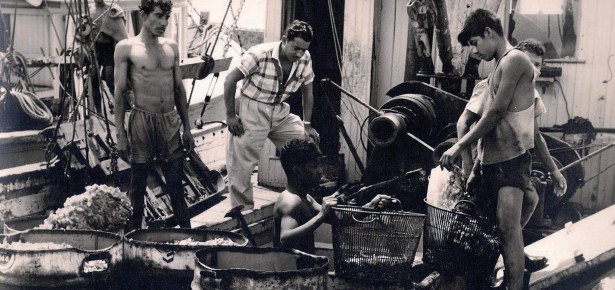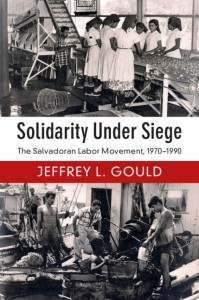
Alejandro Molina Lara, Gloria García, and Ana Alvarenga, the key protagonists in Solidarity Under Siege, all emigrated to North America. During the 1980s, Salvadoran death squads drove them to El Norte. In the early 1990s, many union activists, like Angel Escobar, were blacklisted from the fishing industry while others fled the tropical deindustrialization that accompanied the advent of neoliberalism in Puerto El Triunfo and throughout the country. Just like with today’s emigrants, they deemed the desperate circumstances prompting them to flee their country as far more dangerous than the extreme perils of the migrant journey.
The stories of the Puerto El Triunfo emigrés are not unique. Upwards of half a million Salvadorans departed their country during the Civil War [1980-1992]. Most fled war zones. Right-wing death squads drove thousands like our protagonists towards our borders. The U.S. government played a vital role in provoking these migrations that have shaped subsequent migration patterns. Although the U.S. government did not promote the death squads, it could have reined them in. Instead the U.S. government maintained an alliance with the military whom it bolstered with hundreds of millions of dollars of aid throughout the 1980s. Without the U.S. unwavering support for a military that was guilty of unimaginable human rights abuses, there would not have been the massive exodus of Salvadorans. Those hundreds of thousands of war refugees subsequently would pull many more to the U.S. through family ties.
The US supported a military regime for decades leading up the civil war. We continued to support the military despite its guilt for immense human rights violations, including 8-11,000 unarmed civilians executed in 1980 and the massacre of hundreds of children in El Mozote, Morazán in December of 1981. Throughout the decade, we continued to pump a billion dollars a year into buttressing the Salvadoran government and its military defenders. Some 75,000 civilians died in the conflict, over 90% at the hands of our allies. There is little doubt that the government, given its lack of legitimacy, would not have survived without U.S. support. Thus, one can argue that the United States (rightly or wrongly) bears significant responsibility for the war itself. Ironically, a key leader of the very forces that the US was willing to bend every rule of civilized conduct to defeat was elected president of the republic in 2014. The very political force deemed by the Reagan administration to be “totalitarian” and a tiny minority won and worthy of billions of dollars to eliminate it, won democratic elections in 2009 and 2014.
The war conditioned the immigration crisis in several key respects. First and most significantly most of the over a half a million people ended up in Los Angeles. Those who arrived before 1982 benefited from the amnesty law of 1986, but those who came later faced political deterrent to legality. Unlike Nicaraguans in Miami who sympathized with US policy, the hundreds of thousands of Salvadorans in Los Angeles whose presence raised uncomfortable policy questions generally did not receive refugee status and therefore following the war had no rights to bring their families. Our government granted refugee status to only some 3% of Salvadoran applicants during the 1980s. Over the next decades, the original policy to treat refugee applicants differently based on political considerations continued to haunt the Salvadoran community: many who should have been granted refugee status continue to be undocumented. Today there are some two million Salvadorans in the U.S.
The war and its refugees also conditioned the phenomenon of gangs that in turn has created many more migrants and refugees. In fact the two principal gangs (or maras ) that dominate the Northern Triangle. Mara Salvatrucha and Calle 18, had their origins in Los Angeles during the 1980s. During the 1990s, the U.S. government deported many gang members back to El Salvador, Guatemala, and Honduras despite the fact that the gang members knew little about their supposed native countries and very often spoke little or no Spanish. Once “home” with no alternatives in the forms of educational or job prospects, not surprisingly they recreated their gangs, attracting many local youths. The war, social scientists argue, continued to have its effects on society as many gang members started out as traumatized youths. Moreover, the government forces in El Salvador and even more so in Guatemala enlisted the support of tens of thousands of paramilitaries who operated on the belief that anti-civilian killings were entirely appropriate. At the end of the war in 1992, the paramilitaries and their vast arsenal were unleashed onto the “pacified” society. In short, these transnational gangs would not have emerged without the civil wars.
Yet, there is another element of US policy that conditioned both the gangs and migration. Solidarity Under Siege depicts a key factor in tropical deindustrialization – namely the destruction of the shrimp industry in Puerto El Triunfo. The book shows how the Cold War influenced various players in the conflict that led to the collapse of the industry. That the industry could not be revived had much to do with the emergence of the so-called Washington Consensus that embodied a series of policy orientations that are often labeled neoliberalism. Central American governments adopted these policies, due to US influence: privatization of state run companies such as telecommunications, an end to land reform, a radical reduction in government expenditures especially in the realm of social services, and an end to tariff protection of small farmers and manufacturers. The effects of these policies have been well studied. In sum , they further devastated the war-ravaged region: income inequality skyrocketed and services for the growing sectors of marginalized youth evaporated. Not only did the maras seem like the only game in town for the deportees, but given the growth of marginal neighborhoods, the direct consequence of the war and the neo-liberal policies, they were attractive to native youths. The level of violence of the maras continued to increase over the next decade thanks to the economic incentives of the drug trade and the response of the successive Salvadoran administrations.
Although neither the drug trade nor the mano dura policies against the maras can be directly attributable to U.S. policies, without the market for illegal drugs, there would be little trade. Similarly, the model of zero tolerance promulgated by Mayor Rudy Giuliani to so much media fanfare found eager adherents among Central American governments. The Salvadoran government criminalized membership in the maras with a flagrant disregard for elementary human rights or respect for due process. In 2003, the El Salvadoran government jailed 20,000 gang members. The harsh (and illegal) treatment of gang members engendered an increasingly violent response. To cite just one example: near San Pedro Sula, soon to be baptized the “most dangerous city in the world” mareros attacked a bus killing 28 passengers, leaving a note that the action was in response to a state massacre of 105 gang members in a prison.[Centroamerica: Pandillas y Maras: protgagonistas y chivos expiatorios, Envio Dennis Rodgers 9]. Over 50,000 people belong to affiliates of the two maras in the Northern Triangle José Miguel Cruz “La transformacion de las maras centroamericanas, Cuestiones de Sociología, no 10 2014, La Plata Argentina p1 ] Other estimates are closer to 75,000. [Vargas Ramos Central American Child Emigration Crisis: Facts Figures and Root causes, Carnegie Council for Ethics in International Affairs). The gang members not only occasionally terrorize neighborhoods but their own campaigns to grow specifically target young children basically giving them the option to join or to flee. Close to 60% of migrants cited the maras as the reason for their flight. [us child migrant influx council on foreign relations]
The Washington Consensus package, of course, had more than a stimulating effect on gang growth which in turn has created the influx of children and adult refugees trying to escape the threats and violence. The neoliberal restructuring of the economies has also created fabulous wealth for elites and a more general immiseration of the general populations who have lost any hope in receiving job opportunities, decent health care or education from the vastly reduced governments. Those elites are primarily interested in security and have created the most rapidly expanding sector of the economy, the private security industry. In no way are these elites interested in creating a more inclusive society that might mitigate the attraction of gang membership.
The problem of the maras and their profound effects on emigration are common to all three countries and thus the above description encompasses many aspects of the regional problem. Briefly, let us consider the case of Guatemala. In 1954, the U.S. government engineered the overthrow of the democratically-elected government of Jacobo Arbenz, in effect blocking the democratic road to social change for the next decades. The statement of State Department employee in 1980 encapsulates the tragedy of US policy: “What we would give for an Arbenz today.” Twenty-six years of rightist military rule – fully supported by the US until Carter stopped aid in 1978 – had exacted a horrendous price in human lives. The government and its paramilitary allies gunned down some 20-30,000 unarmed civilians, suspected of “subversion.” The next years would be worse as the Guatemalan military executed some 100,000 civilians, the vast majority of whom were Indians. It is worth noting that the Reagan Administration claimed that the Guatemalan regime had received “a bum rap” in the realm of human rights. The mass exodus from the killing fields accounts for many of the 1.2 million Guatemalans residing in the U.S. and of course the subsequent lethal societal consequences. In some ways the situation is worse than in El Salvador where the political power of the military was sharply curtailed following the military stalemate that led to peace. In Guatemala, our military allies won the war and continue to hold a key position of power. They no longer kill thousands of people but they are far richer and far more corrupt than they were during the 1980s. This violent society, like El Salvador ravaged by neoliberalism, produces huge numbers of migrants a year driven by fear, environmental devastation and unimaginable misery.
The Hondurans story has similarities and differences with its neighbors. High crime and murder rates and increased levels of poverty and inequality have characterized Honduras following the 2009 coup d’état that ousted democratically elected President Manuel Zelaya. Since the 1980s, the nation has had close ties with the United States when it served as a base for U.S. military counter insurgency operations in Central America. Today, trade and investment linkages to the U.S. exist alongside a continued U.S. military presence in the fight against the drug trade. For decades, Honduras has received significant amounts of foreign assistance from the United States. In the 1980s, aid was defined by economic and military goals that supported U.S. policy objectives in Central America, involving the overthrow of the Nicaraguan government and support for the El Salvadoran counter-insurgency effort. Over the past few years the chickens have come home to roost. The blatant illegality and corruption of the Juan Orlando Hernández regime has provoked mass protests and relentless repression driving more and more people on a desperate quest for the border.
Solidarity Under Siege uncovers one cornerstone of the current immigration crisis. The book reveals the deep involvement of the United States in its creation, suggesting that compassion for those fleeing violence should be a major part of our response.
 Solidarity Under Siege: The Salvadoran Labor Movement, 1970–1990 is available now.
Solidarity Under Siege: The Salvadoran Labor Movement, 1970–1990 is available now.
Latest Comments
Have your say!